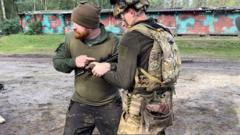Latest news for today in Ukraine
Singapore Professor Yik Ying Teo: If you are caught breaking the law on quarantine, there is the risk of prosecution. It is either a very hefty fine or a jail term. So the public has been very obedient to follow the necessary rules.
Dean of the Saw Swee Hock School of Public Health of the National University of Singapore Professor Yik Ying Teo in his interview with Lithuania’s Lietuvos Rytas told about his country’s ways to curb coronavirus spread and which quarantine measures are taken to various categories of people, as well who is tested primarily.
In Singapore, first confirmed cases of COVID-19 were recorded in the first weeks of the epidemic outbreak in China. However, the tiny state has managed to evade a serious rise in incidence. Dean of the Saw Swee Hock School of Public Health of the National University of Singapore Professor Yik Ying Teo has told about this phenomenon.
Singapore is one of the few countries in the world that managed to contain the outbreak of the novel coronavirus in the country. How did you do it?
It is a mixture of some of the measures that we have put in place in the past. Firstly, what I think we have done very well, is that we try to find the cases as early as possible. So this means that every time we find someone who is infected, and it is a confirmed infection, we trace the contact of that particular individual. We ask the person “Where have you been? Who are the other people you have been in contact with?” and we reach out to all these people to make sure that we isolate them early and we quarantine them if necessary. So that when these people become infectious (because they have been infected), they are in an environment where they do not get to spread it to other people, and I think that has been one of the key success steps we have implemented that has helped to bring down the numbers.
Does it mean you do a lot of testing? Whom and when do you test?
We actually quarantine people first. So, if I have been infected, people that I have been interacting with for the past 14 days, we try our best to identify who these people are and then we isolate them. We do not test them at the very beginning. We only test people who have the symptoms. So this is testing for people who are under quarantine.
The other group of people that we test are people that report to the hospitals and clinics or general practitioners – this is our primary care. We have a checklist: we look for people with persistent high temperature and who have exhibited symptoms that are consistent with a coronavirus infection. These are the people whom we will then prioritize for chest X-rays and then looking for the signs of pneumonia, for signs of lung infections, and, then, if those are confirmed, we test them. So this way we preserve the tests for people who have a high chance of testing positive.
I should emphasize that there are countries like Korea that have done fantastically well. They have been testing many people and that is because they have the capacity to test as many people as they could that are under suspicion of being infected. In Singapore, we could test many as well but we want to be prudent in the use of tests so we have a way of identifying who the people are that should be first isolated and then monitored, and then who the people are that should be fast-forward to be tested immediately.
There is a different understanding in different countries of quarantine rules. How do you quarantine people: at home or at special facilities? How do you ensure that they follow self-isolation at home or elsewhere?
We have three measures. First, we quarantine them at government facilities, so these are buildings we have taken over, including dormitories, student hostels, hotels, that the Government has commandeered. Some of these quarantined people are put in these facilities, food will be delivered to them and they are under watch so they can’t leave the facilities.
The second group of people who are under quarantine are the people who are quarantined at home. For those who are quarantined at home, the Government actually performs regular checks and they use technologies such as GPS locators to make sure that individuals or even families of those individuals stay where they are supposed to be at all times and they are not allowed to leave. For these two groups there are very strict laws that say that if you are caught breaking the law on quarantine because there is an Infectious Disease Act that has been implemented, there is a risk of prosecution. When prosecuted, it is either a very hefty fine or its a jail term. So generally the public in Singapore is quite accustomed to regulations such as this. So the public has been very obedient to follow the necessary rules.
Who is sent to the government facilities and who can stay at home – the first and second groups? What are the criteria?
So the first group is individuals who have been exposed and now need to be brought away from their home because they are family members, and you do not want this person to spread the infection to other people in the family. The second group typically is someone whose whole family is confirmed to have been infected so the entire family is quarantined. And the easiest way to do that is to place the entire family within the same household to avoid any movement. So that is the way to determine who are the ones who should be quarantined at home versus those who are to be quarantined at government facilities. I should also mention that there is a third group of people who are given a “stay at home notice”, which is a level weaker than quarantine but it is still mandatory and it is still governed by Infectious Disease Law. “Stay at home notice” has been implemented now to the people who have no contact with people who are infected but they returned home from places, from countries where there is widespread infection. So, right now, Singapore had implemented a law that put every traveler coming in to Singapore on a “14-day stay home notice”. And I want to emphasize that a “14-day stay home notice” is mandatory and governed by the country’s laws but it is less strict than the quarantine. It requires that individuals stay at home but they can mingle with their family. Quarantine means that an individual or an entire family is completely isolated from the rest of the world, they can’t interact with anyone else that is outside the family or outside the facility.
How do you manage the facilities of the first group? Do people stay in their rooms alone? Is there a possibility that the person is sent to the government facility who had not contracted the disease, but did contract it there because others have been sick?
There’s very low risk of that happening because everyone in government facilities is isolated in single rooms. So, individuals are put one hotel room per individual so there is no risk that I could be in a room with someone else and I may not be infected in the first instance but that person will be and then I get infected by that person. There is no chance of that happening because individuals are in isolation, one room per individual.
Let’s say I have symptoms of the coronavirus, do I call an ambulance, or I call the hospital, or I go to some drive-in? How do you do the testing?
What happens is the following: if I exhibit symptoms, I would call a particular number and the ambulance will come and pick me up, deliver me to the hospital. In the hospital I will be kept in isolation and be checked in the screen before being sent for testing. The testing itself is done in public laboratories managed by the Government.
How many people are there who have already been tested and are sick? How many percent have been hospitalized and how many percent are being treated at home?
In Singapore, 100% of confirmed cases are managed in hospitals at the moment.
What about people who stay at home in Singapore? How do they get their food and necessities they need to survive?
In Singapore, there are online food delivery services that deliver groceries as well as cooked food products so those families that are currently staying at home, rely a lot on online delivery. Generally, because Singapore is quite close-neat, there is a close-neat community spirit, the community rallies around people who stay at home so you have neighbors that perform the delivery, you have relatives who can deliver food and medical supplies for people who have to stay at home. This is a sign that the community has come together to manage this crisis. In China there was the same response as well – they rely on the community spirit and the use of technology to procure food and medical supplies so that individuals can still function despite being locked down.
How long do you think you will have to apply these measures in Singapore and how long will it take in general to curb this pandemic?
This is a question that actually goes beyond Singapore. In Singapore, we rely entirely on trade for a lot of our goods and services. This means that as long as the world is not able to contain this, Singapore will have to keep up these measures. Equally I have made a comment that China has successfully contained the outbreak and we see that they are continuing to get cases from importations. So as long as the world is unable to manage this, every country will have to continue its surveillance and its care in managing important cases.
What can be done in a situation Italy has faced, where the epidemic curve is so sharp?
I think in Italy they are doing the right thing right now, which is a very extensive lockdown and making sure that there is a restriction on people’s movement. As long as the people stay at home, and there is a hotline where citizens can call when they feel unwell, that could be a way of breaking any onward transmission. The country is struggling, the health system is struggling, and there is a need to make sure that the health system is able to recover and to treat the health system efficiently. Right now I am afraid that, based on the numbers that Italy is suffering from, it will be extremely difficult for healthcare workers to administer best quality care to ensure that infection cases are taken care of. So the measures that were put in place, which is an extensive lockdown and ensuring that the basic social functions still continue, that people are able to get access to the essentials like food and medicine, those are essential functions that Italy has done very well. But the extensive lockdown is necessary to break the chain.
We have seen this executed very well in China and now they have successfully contained the outbreak entirely.
What therapy do you use in Singapore for the COVID19 patients?
We are using Remdesivir on trial basis. There is the Interferon for the sick patients that do not meet the trial criteria.
When will we have a vaccine?
The vaccine, with the best scenario, is still about 18 months away.
Tomas Dapkus
Source: www.unian.info



